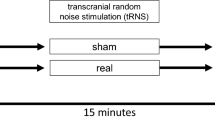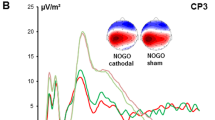Abstract
Exposure to auditory white noise has been shown to facilitate cognitive function. This phenomenon is often called stochastic resonance, and a moderate amount of auditory noise has been suggested to benefit individuals in hypodopaminergic states. Previous studies using psychophysic methods reported that stochastic resonance was sensitive to stimulus intensity; however, the relationship between neural activities elicited by different stimulus intensities and auditory white noise has not yet been clarified Thus, the present study aimed to investigate the effects of stimulus intensity (Experiment 1) and auditory white noise (Experiment 2) on behavioral data (reaction time (RT), the standard deviation of RT, and error rates), and the N140 and P300 components of event-related potentials (ERPs) in somatosensory Go/No-go paradigms. The subjects had to respond to the somatosensory stimuli by pressing a button with their right thumb only after presentation of the Go stimulus. In Experiment 1 with four different stimulus intensity levels, the peak latencies of N140 and P300 became shorter, and the peak amplitudes of N140 and P300 were enhanced with increases in stimulus intensity. In Experiment 2 with weak and mild intensities under auditory white noise and control conditions, the amplitudes of Go-P300 and No-go-P300 were enhanced by white noise, irrespective of weak and mild intensities, during Go/No-go paradigms. Auditory white noise did not significantly affect the amplitude of N140 or the latencies of N140 and P300. These results suggest the presence of a characteristic cross-modal stochastic resonance in neural substrates utilizing somatosensory ERPs.


Similar content being viewed by others
References
Bokura H, Yamaguchi S, Kobayashi S (2001) Electrophysiological correlates for response inhibition in a Go/NoGo task. Clin Neurophysiol 112:2224–2232
Braver TS, Barch DM, Gray JR, Molfese DL, Snyder A (2001) Anterior cingulate cortex and response conflict: effects of frequency, inhibition and errors. Cereb Cortex 11:825–836
Duncan CC, Barry RJ, Connolly JF, Fischer C, Michie PT, Näätänen R, Polich J, Reinvang I, Van Petten C (2009) Event-related potentials in clinical research: guidelines for eliciting, recording, and quantifying mismatch negativity, P300, and N400. Clin Neurophysiol 120:1883–1908
Düzel E, Bunzeck N, Guitart-Masip M, Wittmann B, Schott BH, Tobler PN (2009) Functional imaging of the human dopaminergic midbrain. Trends Neurosci 32:321–328
Falkenstein M, Hoormann J, Hohnsbein J (1999) ERP components in Go/Nogo tasks and their relation to inhibition. Acta Psychol 101:267–291
Fjell AM, Walhovd KB (2003) Effects of auditory stimulus intensity and hearing threshold on the relationship among P300, age, and cognitive function. Clin Neurophysiol 114:799–807
Halgren E, Squires NK, Wilson CL, Crandall PH (1980) Endogenous potentials generated in the human hippocampal formation and amygdala by infrequent events. Science 210:803–805
Hatem SM, Plaghki L, Mouraux A (2007) How response inhibition modulates nociceptive and non-nociceptive somatosensory brain-evoked potentials. Clin Neurophysiol 118:1503–1516
Herweg NA, Bunzeck N (2015) Differential effects of white noise in cognitive and perceptual tasks. Front Psychol 6:1639
Huster RJ, Westerhausen R, Pantev C, Konrad C (2010) The role of the cingulate cortex as neural generator of the N200 and P300 in a tactile response inhibition task. Hum Brain Mapp 31:1260–1271
Inui K, Tran TD, Qiu Y, Wang X, Hoshiyama M, Kakigi R (2003) A comparative magnetoencephalographic study of cortical activations evoked by noxious and innocuous somatosensory stimulations. Neuroscience 120:235–248
Kamijo K, Nishihira Y, Hatta A, Kaneda T, Wasaka T, Kida T, Kuroiwa K (2004) Differential influences of exercise intensity on information processing in the central nervous system. Eur J Appl Physiol 92:305–311
Kida T, Wasaka T, Inui K, Akatsuka K, Nakata H, Kakigi R (2006) Centrifugal regulation of human cortical responses to a task-relevant somatosensory signal triggering voluntary movement. NeuroImage 32:1355–1364
Kopp B, Mattler U, Goertz R, Rist F (1996) N2, P3 and the lateralized readiness potential in a nogo task involving selective response priming. Electroencephalogr Clin Neurophysiol 99:19–27
Lugo E, Doti R, Faubert J (2008) Ubiquitous crossmodal stochastic resonance in humans: auditory noise facilitates tactile, visual and proprioceptive sensations. PLoS One 3:e2860
Manjarrez E, Mendez I, Martinez L, Flores A, Mirasso CR (2007) Effects of auditory noise on the psychophysical detection of visual signals: cross-modal stochastic resonance. Neurosci Lett 415:231–236
Méndez-Balbuena I, Huidobro N, Silva M, Flores A, Trenado C, Quintanar L, Arias-Carrión O, Kristeva R, Manjarrez E (2015) Effect of mechanical tactile noise on amplitude of visual evoked potentials: multisensory stochastic resonance. J Neurophysiol 114:2132–2143
Nakajima Y, Imamura N (2000) Relationships between attention effects and intensity effects on the cognitive N140 and P300 components of somatosensory ERPs. Clin Neurophysiol 111:1711–1718
Nakata H, Inui K, Nishihira Y, Hatta A, Sakamoto M, Kida T, Wasaka T, Kakigi R (2004) Effects of a go/nogo task on event-related potentials following somatosensory stimulation. Clin Neurophysiol 115:361–368
Nakata H, Inui K, Wasaka T, Akatsuka K, Kakigi R (2005) Somato-motor inhibitory processing in humans: a study with MEG and ERP. Eur J Neurosci 22:1784–1792
Nakata H, Sakamoto K, Ferretti A, Perrucci GM, Del Gratta C, Kakigi R, Romani GL (2008a) Somato-motor inhibitory processing in humans: an event-related functional MRI study. NeuroImage 39:1858–1866
Nakata H, Sakamoto K, Ferretti A, Perrucci GM, Del Gratta C, Kakigi R, Romani GL (2008b) Executive functions with different motor outputs in somatosensory Go/Nogo tasks: an event-related functional MRI study. Brain Res Bull 77:197–205
Nakata H, Sakamoto K, Kakigi R (2012) The relationship between reaction time and response variability and somatosensory No-go potentials. Eur J Appl Physiol 112:207–214
Nakata H, Sakamoto K, Honda Y, Kakigi R (2015) Temporal dynamics of neural activity in motor execution and inhibition processing. Eur J Neurosci 41:1448–1458
Nishitani N, Nagamine T, Fujiwara N, Yazawa S, Shibasaki H (1998) Cortical-hippocampal auditory processing identified by magnetoencephalography. J Cogn Neurosci 10:231–247
Ohbayashi W, Kakigi R, Nakata H (2017) Effects of white noise on event-related potentials in somatosensory Go/No-go paradigms. NeuroReport 28:788–792
Rausch VH, Bauch EM, Bunzeck N (2014) White noise improves learning by modulating activity in dopaminergic midbrain regions and right superior temporal sulcus. J Cogn Neurosci 26:1469–1480
Roche RA, Garavan H, Foxe JJ, O’mara SM (2005) Individual differences discriminate event-related potentials but not performance during response inhibition. Exp Brain Res 160:60–70
Romo R, Lemus L, de Lafuente V (2012) Sense, memory, and decision-making in the somatosensory cortical network. Curr Opin Neurobiol 22:914–919
Salimpoor VN, Benovoy M, Larcher K, Dagher A, Zatorre RJ (2011) Anatomically distinct dopamine release during anticipation and experience of peak emotion to music. Nat Neurosci 14:257–262
Schmidt RA (2001) Motor learning and performance. Human Kinetics, Champaign, USA, pp 55–87
Shibasaki M, Namba M, Oshiro M, Kakigi R, Nakata H (2017) Suppression of cognitive function in hyperthermia; from the viewpoint of executive and inhibitive cognitive processing. Sci Rep 7:43528
Sikström S, Söderlun G (2007) Stimulus-dependent dopamine release in attention-deficit/hyperactivity disorder. Psychol Rev 114:1047–1075
Sikström S, Jürgensen AM, Haghighi M, Månsson D, Smidelik D, Habekost T. Self-rated attentiveness interacts with transcranial direct current stimulation and noise stimulation in reaction time in a Go/No-Go task. Neural Plast. 2016; 2016: 5302538
Söderlund GB, Sikström S, Loftesnes JM, Sonuga-Barke EJ (2010) The effects of background white noise on memory performance in inattentive school children. Behav Brain Funct 6:55
Sugg MJ, Polich J (1995) P300 from auditory stimuli: intensity and frequency effects. Biol Psychol 41:255–269
Teichner WH (1954) Recent studies of simple reaction time. Psychol Bull 51:128–149
Treviño M, De la Torre-Valdovinos B, Manjarrez E (2016) Noise improves visual motion discrimination via a stochastic resonance-like phenomenon. Front Hum Neurosci 10:572
Usher M, Feingold M (2000) Stochastic resonance in the speed of memory retrieval. Biol Cybern 83:L11–L16
Author information
Authors and Affiliations
Corresponding author
Ethics declarations
Conflict of interest
There are no conflicts of interest.
Rights and permissions
About this article
Cite this article
Mizukami, H., Kakigi, R. & Nakata, H. Effects of stimulus intensity and auditory white noise on human somatosensory cognitive processing: a study using event-related potentials. Exp Brain Res 237, 521–530 (2019). https://doi.org/10.1007/s00221-018-5443-8
Received:
Accepted:
Published:
Issue Date:
DOI: https://doi.org/10.1007/s00221-018-5443-8




